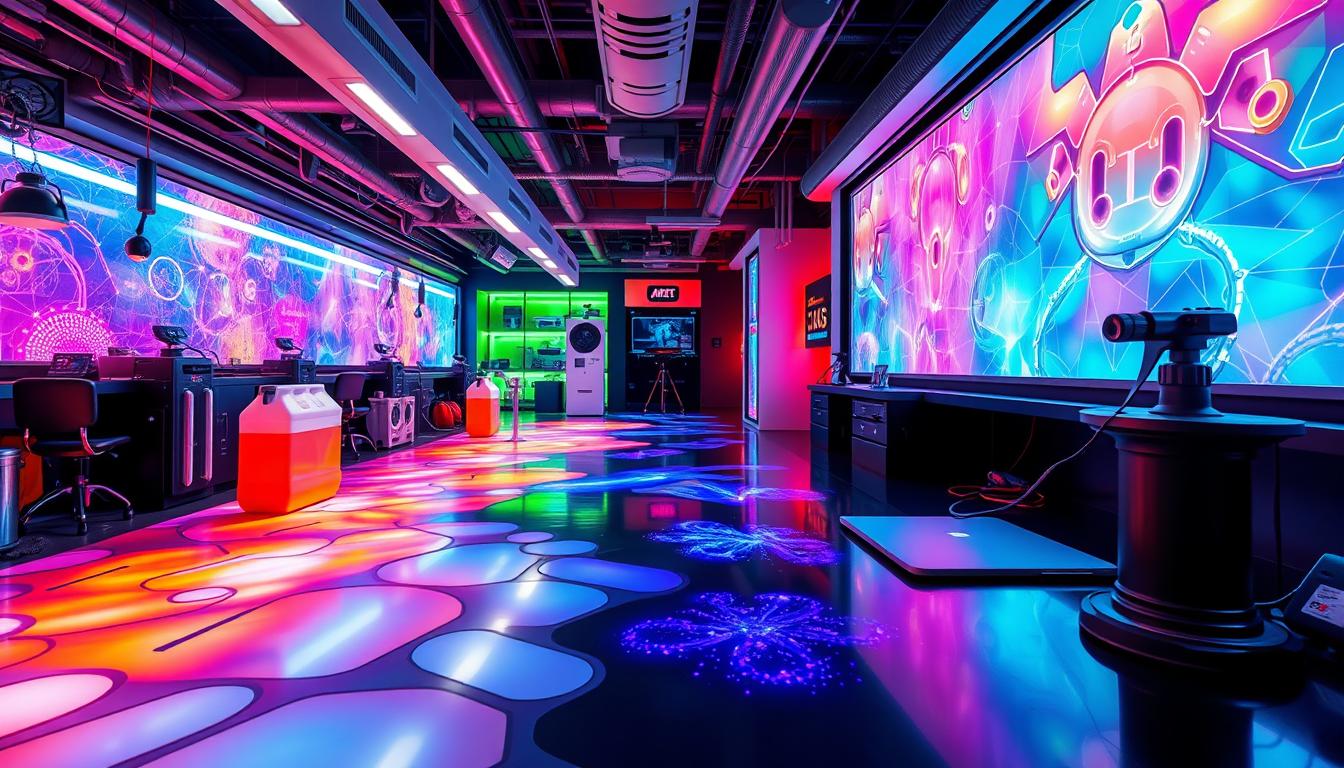Paint innovation has seen tremendous progress, with new technologies surfacing daily. The paint industry is undergoing a significant transformation. This change is driven by advancements in paint innovation and the adoption of new technology. This shift promises to revolutionize our understanding of paint and its uses.
Smart paint technologies are bringing numerous benefits, including enhanced durability and aesthetic appeal. The integration of new technology into paint innovation is unlocking new possibilities across various sectors. This includes construction and design.
The future of paint appears bright, with ongoing research and development in paint innovation and new technology. As we explore the latest advancements in smart paint technologies, we will dive into the world of paint innovation. We will discuss the benefits, applications, and future prospects of these emerging technologies.
Key Takeaways
- Paint innovation is driving the transformation of the paint industry
- New technology is emerging every day, offering improved benefits and applications
- Smart paint technologies are expected to revolutionize various industries, including construction and design
- Research and development in paint innovation and new technology are ongoing
- The future of paint looks promising, with a wide range of benefits and applications
- Paint innovation and new technology are opening up new possibilities for industries
- Smart paint technologies are enhancing aesthetic appeal and durability
Understanding Modern Paint Technology Revolution
The modern paint technology revolution has reshaped the construction and design sectors. It brings modern features like better durability and enhanced looks. Advanced coatings play a key role, offering benefits like energy savings and self-cleaning abilities.
Modern paint technology offers several advantages:
- Improved durability, leading to lower maintenance costs
- Enhanced aesthetics, opening up more design possibilities
- Energy efficiency, aiding in a greener future
- Self-cleaning properties, cutting down on frequent cleaning needs
The demand for modern features and advanced coatings is on the rise. This trend is expected to drive more innovation in construction and design. Smart paint technologies will likely lead to even more groundbreaking advancements.
The influence of modern paint technology on construction and design is immense. As we explore new possibilities with advanced coatings and modern features, we’re heading towards a future. This future will see buildings and designs that are not just sustainable but also efficient and beautiful.
| Benefit | Description |
|---|---|
| Improved Durability | Reduced maintenance costs and extended lifespan |
| Enhanced Aesthetics | Wider range of design options and improved appearance |
| Energy Efficiency | Contribution to a more sustainable future and reduced energy costs |
Self-Cleaning Paint: The Future of Low Maintenance
Self-cleaning paint is a groundbreaking technology that’s reshaping our approach to building upkeep. It boasts smart features that slash maintenance expenses and boost structure performance. This paint leverages nanotechnology and photocatalytic materials to disintegrate dirt and grime. As a result, surfaces remain pristine with minimal effort.
The advantages of self-cleaning paint are vast, encompassing lower upkeep costs, enhanced durability, and a more appealing look. Its smart features include:
- Water-repellent properties
- Anti-microbial properties
- UV resistance
- Self-healing capabilities
Its applications span from commercial edifices to private residences, and even the automotive sector. Self-cleaning paint’s smart features make it a compelling choice for those aiming to cut maintenance expenses and elevate surface performance.
As the tech advances, we anticipate more advanced smart features in self-cleaning paint. Its potential to diminish upkeep costs and elevate surface performance marks it as a pivotal innovation in paint technology.
| Feature | Benefit |
|---|---|
| Water-repellent properties | Reduced water damage |
| Anti-microbial properties | Improved hygiene |
| UV resistance | Increased durability |
Color-Changing Paint Technologies
Color-changing paint technologies are transforming our understanding of paint advancements and future directions. These paints can alter their hue in response to temperature, light, or other environmental factors. This innovation is unlocking new avenues for both design and practical use.
At the forefront of this transformation is thermochromic applications. These paints adjust their color based on temperature changes. This makes them perfect for smart control systems. For instance, a thermochromic paint could signal when a surface has reached a specific temperature, offering a visual alert.
Thermochromic Applications
Thermochromic paints are being explored in various fields, including:
- Smart control systems
- Temperature indicators
- Design and display
Photochromic Developments
Photochromic paints, by contrast, change color with light exposure. These paints are being developed for diverse uses, such as self-adjusting windows and dynamic displays.
Smart Control Systems
Smart control systems are a significant focus for color-changing paint technologies. By combining these paints with sensors and control systems, we can create systems that dynamically respond to environmental changes.
| Technology | Application | Benefits |
|---|---|---|
| Thermochromic | Smart control systems | Visual warning or signal |
| Photochromic | Self-adjusting windows | Energy efficiency |
Anti-Bacterial and Antimicrobial Coatings
Recent advancements in paint technology have introduced anti-bacterial and antimicrobial coatings. These innovations aim to curb the spread of bacteria and other microorganisms. This is a significant step forward in public health. Researchers have successfully developed coatings for various surfaces, including hospital equipment and household items, thanks to new technology.
The advantages of these coatings are vast. They can lower infection risks, enhance hygiene, and foster a healthier environment. Key areas where these coatings are applied include:
- Hospitals and healthcare facilities
- Households, notably in humid or moist areas
- Public transportation, such as buses and trains
As paint innovation progresses, we anticipate more advanced and effective coatings. New technology will make these coatings more widespread and affordable. By embracing these coatings, we pave the way for a healthier and more sustainable future
Energy-Efficient Paint Solutions
In our quest to lower our carbon footprint, energy-efficient paint solutions are gaining traction. These options combine modern features and advanced coatings, offering numerous benefits for both buildings and homeowners. A standout feature is their ability to minimize heat gain and loss. This leads to lower energy bills and a more pleasant living or working environment.
Heat-Reflective Technologies
Heat-reflective technologies are a cornerstone of energy-efficient paint. They employ specialized pigments that reflect solar radiation, rather than absorbing it. This approach helps to curb the amount of heat entering a building. As a result, it reduces cooling costs and diminishes the need for air conditioning.
Insulating Paint Compounds
Insulating paint compounds are another vital component of energy-efficient paint. These compounds are engineered to offer thermal insulation, cutting down on heat loss and gain. They can be applied to walls, ceilings, and floors. This provides a multitude of advantages, including lower energy bills and enhanced comfort.
Cost-Benefit Analysis
An examination of the cost-benefit analysis for energy-efficient paint solutions shows substantial savings. While the initial investment might be higher than traditional paint, the long-term advantages justify the expense. Key benefits include:
- Reduced energy bills
- Increased comfort and productivity
- Extended lifespan of buildings and materials
- Environmental benefits and reduced carbon footprint
Environmental Impact of Smart Paint Technologies
Adopting smart paint technologies raises important questions about their environmental impact. These technologies, with a focus on smart features, can be crafted to reduce their ecological footprint. This is achieved through the use of eco-friendly materials and sustainable production methods.
Smart paint technologies can lower their environmental impact in several ways:
- Utilizing natural ingredients and minimizing volatile organic compounds (VOCs)
- Implementing recycling programs for paint containers and materials
- Developing energy-efficient production processes
Smart features such as self-cleaning and anti-bacterial properties help reduce environmental impact. They minimize the need for frequent cleaning and maintenance. Features like color-changing and thermochromic properties also contribute. These can be used to create energy-efficient and sustainable building designs.
By integrating smart features and sustainable practices, the environmental footprint of smart paint technologies can be greatly diminished. This makes them a more appealing choice for those who prioritize environmental consciousness.
Nano-Enhanced Paint Features
Nano-enhanced paint features are transforming the paint industry with groundbreaking advancements. These innovations aim to enhance paint performance, making it more durable and resistant to scratches. This shift is driven by the exploration of new technologies.
Key benefits of nano-enhanced paint include improved scratch resistance, self-repairing capabilities, and enhanced durability. These attributes stem from the incorporation of nanoparticles. These tiny particles, measured in nanometers, enable paints to exhibit unique properties. For instance, they can repair themselves after scratches or damage.
Scratch-Resistant Properties
Scratch-resistant properties are a major advantage of nano-enhanced paints. This is crucial in sectors like automotive and aerospace, where damage can be expensive to fix. With these paints, manufacturers can produce products that withstand scratches and damage better. This reduces the need for costly repairs and maintenance.
Self-Repairing Capabilities
Self-repairing capabilities are another significant benefit. This technology enables paints to mend themselves after scratches or damage, eliminating the need for expensive repairs. The magic behind this lies in nanoparticles that can flow and fill in scratches. This restores the paint to its pristine state.
Durability Improvements
Durability improvements are a major plus of nano-enhanced paints. By integrating nanoparticles, manufacturers can craft paints that resist fading, cracking, and other damage better. This leads to a longer paint lifespan, reducing the frequency of repairs and maintenance. As the paint industry continues to evolve, we can anticipate even more groundbreaking technologies.
Smart Sensors and Interactive Paint Systems
Paint innovation has led to the development of smart sensors and interactive paint systems. These systems use new technology to detect and respond to environmental changes. They are perfect for various applications, from smart homes to intelligent buildings. The potential uses of these systems are vast.
Some of the key features of smart sensors and interactive paint systems include:
- Environmental monitoring: detecting changes in temperature, humidity, and light
- Automated responses: adjusting lighting, temperature, and other settings based on environmental conditions
- Energy efficiency: optimizing energy consumption through smart sensors and automated systems
As paint innovation continues to advance, we can expect to see even more sophisticated smart sensors and interactive paint systems. With the integration of new technology, these systems will become increasingly efficient, sustainable, and user-friendly.
Cost Considerations and ROI Analysis
Adopting smart paint technologies requires a careful look at costs. The initial investment in modern features and advanced coatings might seem steep. Yet, it’s vital to consider the long-term gains. Homeowners and businesses can see a substantial return on investment, thanks to lower maintenance costs and enhanced durability.
The cost of smart paint technologies varies based on the chosen features and coatings. Initial costs include the purchase price, application fees, and upkeep. Many manufacturers offer warranties or guarantees, providing consumers with added reassurance.
Initial Investment Requirements
The initial investment for smart paint technologies can range from a few hundred to several thousand dollars. This depends on the project’s scope. Common costs include:
- Materials and supplies: $500-$2,000
- Application and labor costs: $1,000-$5,000
- Equipment and tools: $500-$1,000
Long-term Value Proposition
The initial investment in smart paint technologies may seem high. Yet, the long-term benefits far exceed the costs. Key advantages include:
- Reduced maintenance costs: $500-$1,000 per year
- Improved durability: 5-10 years or more
- Enhanced aesthetic appeal: increased property value
Maintenance Cost Comparison
To show the cost savings of smart paint technologies, consider this comparison:
| Traditional Paint | Smart Paint Technologies |
|---|---|
| $1,000 – $3,000 per year (maintenance and upkeep) | $500 – $1,000 per year (reduced maintenance costs) |
Investing in modern features and advanced coatings leads to significant long-term savings. This makes smart paint technologies a worthwhile investment for any homeowner or business.
Installation and Application Techniques
Smart paint technologies require specialized installation and application techniques. This is because they have unique smart features like self-cleaning and color-changing properties. To achieve a successful installation, it’s crucial to adhere to best practices and employ the correct equipment.
Key considerations for installing smart paint technologies include:
- Surface preparation: The surface must be properly prepared to ensure a strong bond between the paint and the surface.
- Application methods: The application method will depend on the specific type of smart paint being used, and may include techniques such as spraying or rolling.
- Environmental conditions: The environmental conditions, such as temperature and humidity, must be taken into account to ensure a successful installation.
By following these best practices and using the right equipment, individuals can ensure a successful installation of smart paint technologies. They will then enjoy the benefits of their smart features.
Market Leaders and Brand Comparison
The market for smart paint technologies is rapidly evolving, with numerous manufacturers competing for market share. Companies like Sherwin-Williams and Behr lead the way, driving innovation and growth. They invest heavily in research and development, focusing on sustainable and eco-friendly paints.
Some of the top manufacturers in the industry include:
- Sherwin-Williams
- Behr
- PPG Industries
These companies have consistently received high ratings for performance reviews and customer satisfaction. For instance, Sherwin-Williams is known for its high-quality products and excellent customer service. As demand for smart paint technologies grows, these companies are well-positioned to capitalize on future trends.
In conclusion, the market for smart paint technologies is highly competitive, with numerous manufacturers competing for market share. Companies like Sherwin-Williams and Behr are driving innovation and growth by focusing on paint developments and future trends.
Conclusion: The Future of Paint Technology
The paint technology world is witnessing a significant shift. Innovations like self-cleaning coatings and color-changing paints are leading the charge. These advancements are reshaping our understanding of surface protection and beauty.
Looking ahead, the paint industry’s future is filled with promise. We can anticipate more advanced coatings and smart features. These will grant users greater control and personalization. Paint developments will likely focus on energy efficiency, antimicrobial properties, and durability.
The evolution of paint technology will fundamentally change our interaction with our surroundings. By embracing these new technologies, we’re set to see paints that are more sustainable, easier to maintain, and smarter. These innovations will significantly influence construction, design, and other fields.


